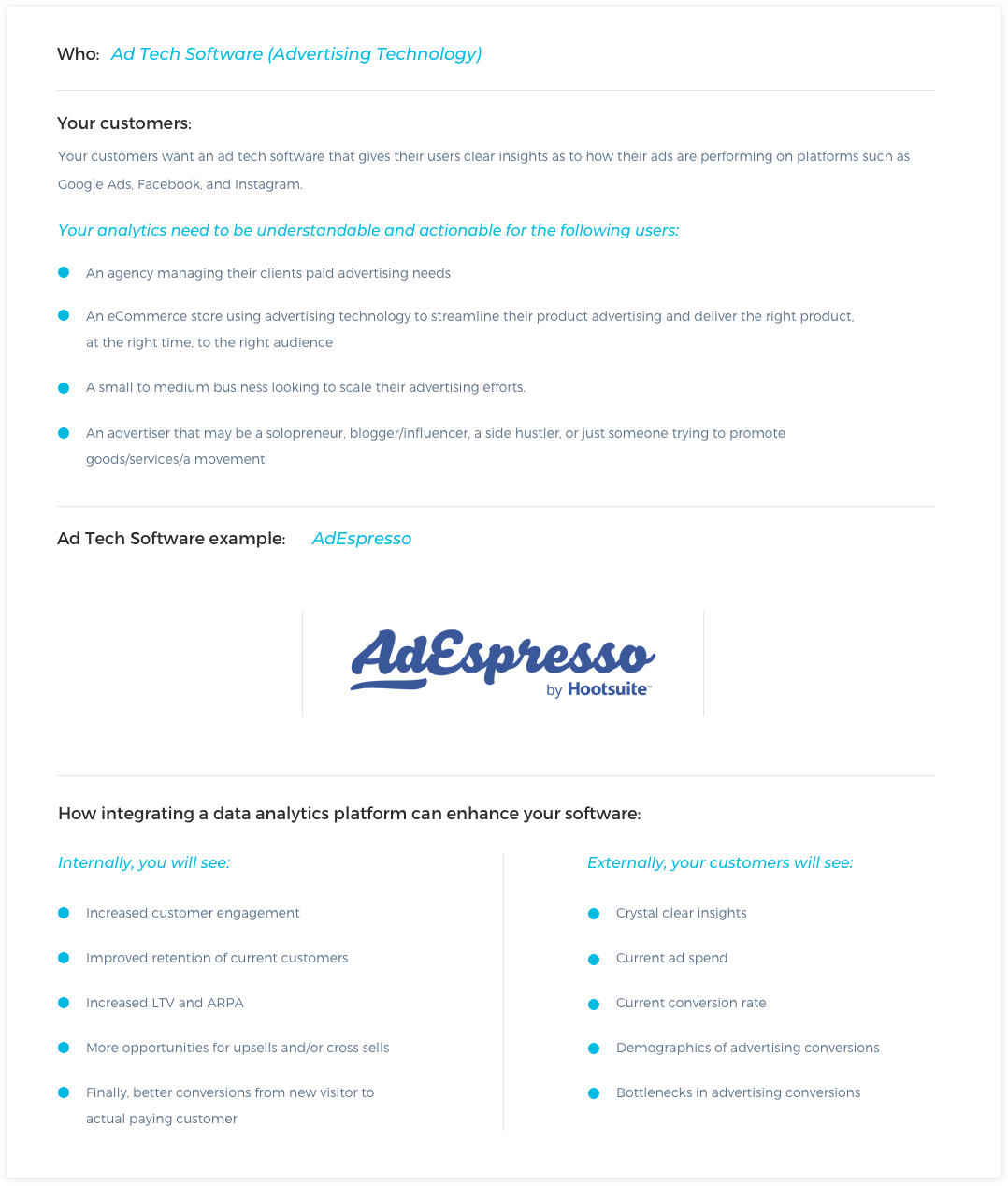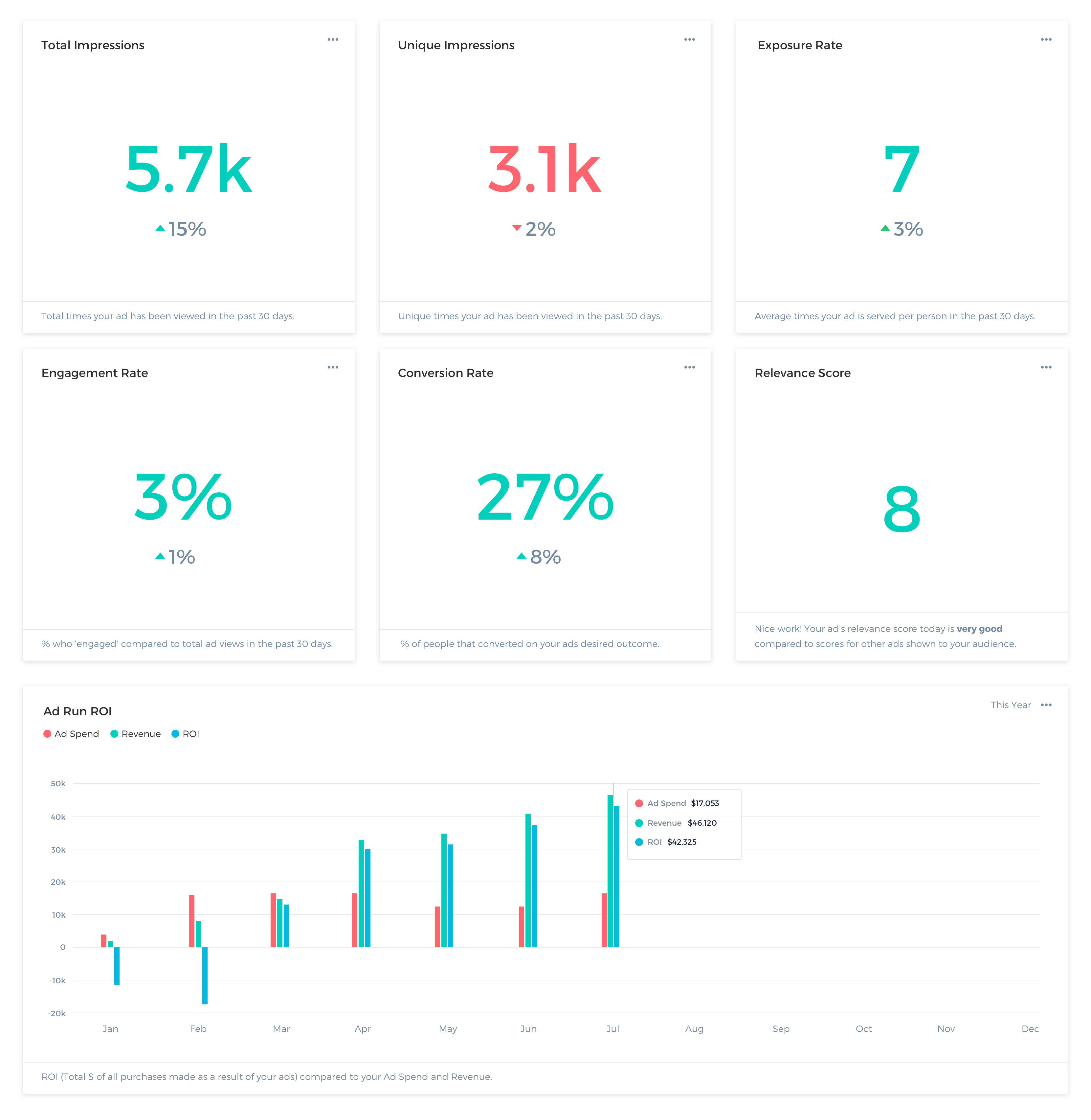In a world of ever-changing algorithms and software updates, it’s critical now more than ever that advertisers have access to the analytics they need to get the best results for their ad spend. It’s far too easy to shell out thousands of dollars on advertising campaigns, only to be left with no conversions, no revenue, and a hefty amount of disappointment.
How can ad tech software companies provide their customers with the data they need to get the most bang for their advertising bucks?
Enter customer facing metrics – the key to honing in on where your customer’s money should go, where it is currently going, and whether or not they’re actually making headway in their promotional efforts.
Customer facing metrics is the visual data that shows a user the exact information they are looking for related to usage and performance, and in a way that is actionable. Numbers mean nothing out of context. What people really need is a visual representation of the numbers that answer the questions they are already asking.
What’s the difference between MarTech and AdTech?
Before we go any further, we thought it would be a good idea to address this, as many people use the terms MarTech and AdTech interchangeably. Is there a difference? The answer is a little bit blurry.
The truth is that AdTech (short for advertising technology) is actually a small subset of MarTech (short for marketing technology). The reason the line is so often blurred is it’s essentially trying to explain the difference between marketing and advertising – both have the goal of promoting a brand or an idea, but advertising is just one branch of the marketing promotional tree.
In AdTech, the focus is on the paid advertising campaigns, and all the metrics and data related to that. MarTech is about the broader promotions that drive traffic to your business website. MarTech is made up of the things that go beyond the paid campaigns such as outreach via email, social media, snail mail, expos, and other in-person promotional efforts.
Where AdTech looks at the analytics of impressions, click throughs, and engagement of paid advertising, MarTech looks at things like web analytics, social media engagement, personalization, SEO, marketing automation, and customer-relationship management (CRM).
Finally, AdTech is a paid media campaign to several, unknown recipients, with the goal of converting them from unknown to interested party and/or paying customer. MarTech is the broader, unpaid promotional efforts via owned channels, social media profiles, and email and snail mail addresses, targeting a known database of potential or current customers.

Goals
The goal of advertising technology software is to help your customers’ users get a crystal clear, visual representation, of their current ad spend and how it’s working for them. They want to reach their ideal clients, and convert them from ad viewer, to website visitor or paying customers.
With that in mind, users of ad tech software need to know who is viewing their ad, how many people are clicking, if the ad converts into traffic and/or purchases, which ads are performing the best, and so much more. They also want to view their digital advertising analytics in one place that breaks down their results in easy to read graphics, instead of needing to open each advertising platform and decipher the results they are receiving for themselves.
Challenges when trying to Reach These Goals
Nothing is more frustrating to a user than having to wade through dozens of data and metrics, put it together in a way that is easy to analyze, and try to figure out what is actually working in their business. Today’s advertisers want clear widgets and graphs that show them without a shadow of a doubt where there advertising dollars are yielding the most returns.
When looking at the analytics within individual advertising platforms such as Google Ads, Facebook, or Instagram, it’s easy to get overwhelmed by the plethora of data delivered. That’s why your customers are looking to offer their users real-time data that quickly and easily aids them in making better decisions for their advertising campaigns.
They want it to be easier to:
Compare/contrast results of past and present campaigns: For example, perhaps some ads were more successful at the beginning of the year than during the summer, or maybe the ads with less text had the best results.
A/B test current advertising campaigns: Sometimes a user wants to run to different ads at the same time to see which one performed the best. They need real-time results that can help them determine which of the two ads worked best for their goals.
Adjust their campaigns quickly if something isn’t working/resonating with their target audience: Should they push pause on their current campaigns, or perhaps extend them because they are resonating well with the intended audience?
Learn the best times to send out ads, and the best platforms to advertise with: Maybe weekends are the best times for ads to go live because their ideal customers are only online then, or perhaps weekdays are best because customers are using their coffee breaks to scroll through news feeds.
Determine their current click through rate, cost per click, number of ad impressions, and overall return on investment: The more information a user has at hand, the easier it is to determine which ads are successful, and what tweaks need to be made to their current and future campaigns.
Predict which campaigns will be the most successful in the future: Imagine having data that acts as a crystal ball. That could mean big results for your AdTech software customers’ users, resulting in higher customer retention for both you and your customer.
Digital Advertising Analytics in Real Time

Your customers’ users don’t just want a bunch of random information delivered to them. They want a snapshot that is easy to understand, complete with the customer-facing metrics that actually matter to them and their ad campaign goals.
At a minimum, your AdTech software analytics should include:
- Impressions – How many people saw their ad?
- Exposure rate – How many times did a person see the same ad?
- Engagement rate – How many people clicked the ad?
- Conversion rate – What is the number of people that became buyers and/or visitors as a result of clicking the ad?
- Relevance score – What was the ad’s effectiveness and relevance to the audience?
- Revenue/return on investment – What was the total value of the purchases that were made as a direct result of engaging with an advertisement?
When you create the right data model, you can deliver metrics like this to your customers with as little as the following three events:
- Ad Views
- Engagement
- Purchases
Your customers’ users want to run their advertising campaigns with confidence. With customer-facing metrics you can provide the end user with the data they need to see where they are at with their marketing goals, and insight into how to improve their current campaigns in an effort to achieve those goals.
Embedding Digital Advertising Analytics
The big question most AdTech software companies ask themselves is, how can you develop customizable data dashboards for both your customer, and their end users? What is the best way to provide a custom analytics platform that is flexible and powerful enough to give your customers and their users the answers they are looking for?
After much research, you’ll likely find you have two options:
- Build your dashboards yourself, which can be incredibly costly and time consuming for your company or
- Hire a company like Keen, who can not only build dashboards like any out of the box solution, but can also build custom advanced dashboards that cater specifically to your customers needs.
We break this down further in our Build vs. Buy whitepaper, but below is the gist of what you really need to know.
Here’s the thing – you could build a custom analytics solution of your own, and it might be the perfect option for you if:
- Your company can afford to shell out hundreds if not thousands of dollars hiring the right people to build it, and have them stick around long enough to complete the build
- You have plenty of time to spare, and aren’t in a rush to get your solution out to your customers
- You don’t mind spending more money and time on maintenance and updates
- You’re okay with the possibility that it won’t fulfill your needs and that it might not ever be finished.
The better way is to work with a company that isn’t building a solution for the first time. Partner with someone who’s not only done this before, but can give you a custom solution that meets your company’s unique needs.
With Keen by your side, you can create a custom AdTech Dashboard that is specific to your industry. Keen can help you develop a dashboard that analyzes ad campaigns for 20M impressions in just seconds.
AdTech event data is happening at an incredibly large scale. Every second, millions or even billions of impressions or plays are occurring. Your customers’ users need access to the data that is being created as a result of those events.
Companies need this information as quickly as possible because in the case of ad spend, time is in fact money. Every moment that an ad is not converting could mean hundreds of thousands of dollars in wasted expenses, and lost opportunities for revenue.
That is why companies want instant queries so that at any given time they can pull the plug on campaigns that aren’t working. Bottom line – If you’re not delivering a dashboard that shows whether or not an ad campaign is proving successful, you aren’t helping your customers deliver the most critical information to their users.
You owe it to your software company, and to your customers to partner with Keen to build custom dashboards specific to your industry. They are more than just a partner. They will be your key to creating a custom analytics platform that is simple and advanced, and they will help you do it faster and cheaper than other solutions available to you.
What are you waiting for? The data your customers want is needed now. Request a Demo today!




